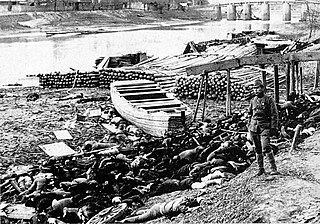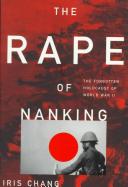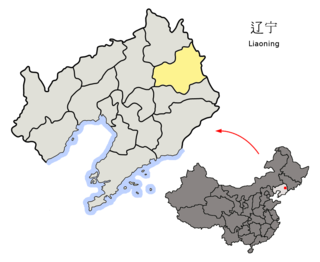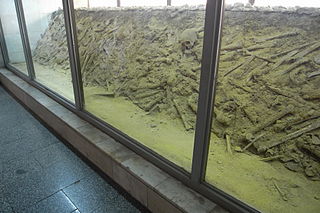Related Research Articles

The Nanjing Massacre or the Rape of Nanjing was the mass murder of Chinese civilians in Nanjing, the capital of the Republic of China, immediately after the Battle of Nanking in the Second Sino-Japanese War, by the Imperial Japanese Army. Beginning on December 13, 1937, the massacre lasted six weeks. The perpetrators also committed other war crimes such as mass rape, looting, and arson. The massacre is considered to be one of the worst wartime atrocities.

The Rape of Nanking: The Forgotten Holocaust of World War II is a bestselling 1997 non-fiction book written by Iris Chang about the 1937–1938 Nanjing Massacre — the mass murder and mass rape of Chinese civilians committed by the Imperial Japanese Army in Nanjing, the capital of the Republic of China, immediately after the Battle of Nanjing during the Second Sino-Japanese War. It describes the events leading up to the Nanjing Massacre, provides a graphic detail of the war crimes and atrocities committed by Japanese troops, and lambastes the Japanese government for its refusal to rectify the atrocities. It also criticizes the Japanese people for their ignorance about the massacre. It is one of the first major English-language books to introduce the Nanjing Massacre to Western and Eastern readers alike, and has been translated into several languages. The book significantly renewed public interest in Japanese wartime conduct in China, Korea, Southeast Asia and the Pacific.

The February 28 incident was an anti-government uprising in Taiwan that was violently suppressed by the Kuomintang–led nationalist government of the Republic of China (ROC). Directed by provincial governor Chen Yi and president Chiang Kai-shek, thousands of civilians were killed beginning on February 28, 1947. The incident is considered to be one of the most important events in Taiwan's modern history and was a critical impetus for the Taiwan independence movement.

Sook Ching was a mass killing that occurred from 18 February to 4 March 1942 in Singapore after it fell to the Japanese. It was a systematic purge and massacre of 'anti-Japanese' elements in Singapore, with the Singaporean Chinese particularly targeted by the Japanese military during the occupation. However, Japanese soldiers engaged in indiscriminate killing, and did not try to identify who was 'anti-Japanese.' Singapore was a crucial strategic point in World War II. From 8 February to 15 February, the Japanese fought for control of the city. The combined British and Commonwealth forces surrendered in a stunning defeat to the outnumbered Japanese on 15 February which led to its fall. The loss of Singapore was and still is Britain's largest surrender in history.

Benxi is a prefecture-level city located in the east of Liaoning province, People's Republic of China, south-southeast of the provincial capital Shenyang. As of the 2020 census, its population was 1,326,018 whom 809,655 lived in the built-up area made of 3 urban districts. It was founded as a metallurgical center in 1915. Benxi Iron and Steel Company (Bengang) is the largest employer in the city, and used to be the fourth-largest steel company in China. The second-largest industry in Benxi is coal mining. The city has pollution problems due to steel production and coal mining.

Fushun is a prefecture level city in Liaoning province, China, about 45 km (28 mi) east of Shenyang, with a total area of 11,272 km2 (4,352 sq mi), 714 km2 (276 sq mi) of which is the city proper. Situated on the Hun River, it is one of the industrial and economic development hubs in Liaoning.

Pingdingshan, also known as Eagle City, is a prefecture-level city in central Henan province, China. It had 4,904,701 inhabitants at the 2010 census whom 1,756,333 lived in the built-up area including Ye county being conurbated.
The Tongzhou mutiny, sometimes referred to as the Tongzhou Massacre, was an assault on Japanese civilians and troops by the collaborationist East Hebei Army in Tongzhou, China, on 29 July 1937, shortly after the Marco Polo Bridge Incident, which marked the official beginning of the Second Sino-Japanese War.

The Pacification of Manchukuo was a Japanese counterinsurgency campaign to suppress any armed resistance to the newly established puppet state of Manchukuo from various anti-Japanese volunteer armies in occupied Manchuria and later the Communist Northeast Anti-Japanese United Army. The operations were carried out by the Imperial Japanese Kwantung Army and the collaborationist forces of the Manchukuo government from March 1932 until 1942, and resulted in a Japanese victory.

The Przyszowice massacre was a massacre perpetrated by the Red Army against civilian inhabitants of the Polish village of Przyszowice in Upper Silesia during the period January 26 to January 28, 1945. Sources vary on the number of victims, which range from 54 to over 60 – and possibly as many as 69. The Institute of National Remembrance, a Polish organization that carried out research into these events, has declared that the Przyszowice massacre was a crime against humanity.

The Memorial Hall of the Victims in Nanjing Massacre by Japanese Invaders is a museum to memorialize those that were killed in the Nanjing Massacre by the Imperial Japanese Army in and around the then-capital of China, Nanjing, after it fell on December 13, 1937. It is located in the southwestern corner of downtown Nanjing known as Jiangdongmen (江东门), near a site where thousands of bodies were buried, called a "pit of ten thousand people".

Jinning Township is a rural township in Kinmen, Republic of China. It is in the Taiwan Strait, on the coast of mainland China. It has a population of 34,569 and an area of 29.8540 km2 (11.5267 sq mi).

The Geochang massacre was a massacre conducted by the third battalion of the 9th regiment of the 11th Division of the South Korean Army between 9 February 1951 and 11 February 1951 of 719 unarmed citizens in Geochang, South Gyeongsang district of South Korea. The victims included 385 children. The 11th Division also conducted the Sancheong-Hamyang massacre two days earlier. The general commanding the division was Choe Deok-sin.
Hisashi Inoue is a Japanese historian. His area of expertise is modern Chinese history and Sino-Japanese relations. Since 2001 he has been a professor in the faculty of law at Surugadai University after having served as associate professor at the same university.

The total death toll of the Nanjing Massacre is a highly contentious subject in Chinese and Japanese historiography. Following the outbreak of the Second Sino-Japanese War, the Japanese Imperial Army marched from Shanghai to the Chinese capital city of Nanjing (Nanking), and though a large number of Chinese POWs and civilians were slaughtered by the Japanese following their entrance into Nanjing on December 13, 1937, the precise number remains unknown. Since the late-1960s when the first academic works on the Nanjing Massacre were produced, estimating the approximate death toll of the massacre has been a major topic of scholarly debate.
Pingdingshan was a village in Dongzhou District, Fushun City, Liaoning Province, China. Most of the population was killed during the Pingdingshan massacre.

East District is a district in east Chiayi City, Taiwan. The district is the city seat of Chiayi City.

Sandakan Massacre Memorial consists of three monuments which commemorate 30 Chinese victims, most of the members are local elite of an underground movement who been executed on 27 May 1945 along with several other victims during the Japanese occupation of North Borneo. The memorial was built on the spot where the massacre took place and where the victims were buried. It is located near a Chinese cemetery on a hill above the old town centre of Sandakan.

The Axum massacre was a massacre of about 100–800 civilians that took place in Axum during the Tigray War. The main part of the massacre occurred on the afternoon and evening of 28 November 2020, continuing on 29 November, with smaller numbers of extrajudicial killings taking place earlier, starting from 19 November and during the weeks following the 28–29 November weekend. The massacre was attributed to the Eritrean Defence Forces (EDF) by Amnesty International, Associated Press, the Ethiopian Human Rights Commission (EHRC), Human Rights Watch (HRW) and Adigrat University lecturer Getu Mak.

The National Memorial Day for the Victims of the Nanjing Massacre is a national memorial day observed in China on 13 December annually in honor of the Chinese victims of the Second Sino-Japanese War. The observance draws attention to Japanese war crimes during this period. It was established in 2014 by the Standing Committee of the 12th National People's Congress.
References
- ↑ 田辺敏雄 『追跡平頂山事件』 図書出版社 1988年12月